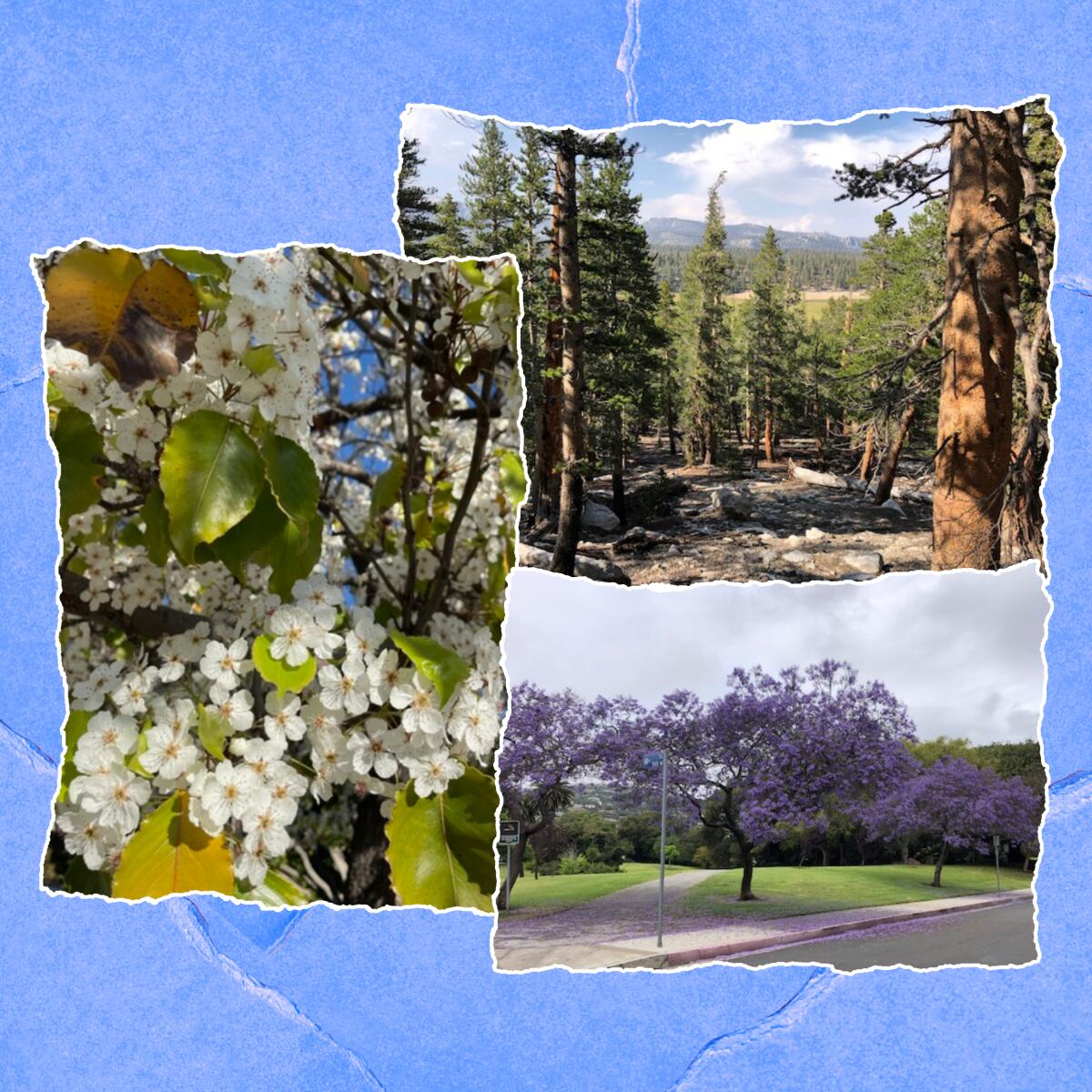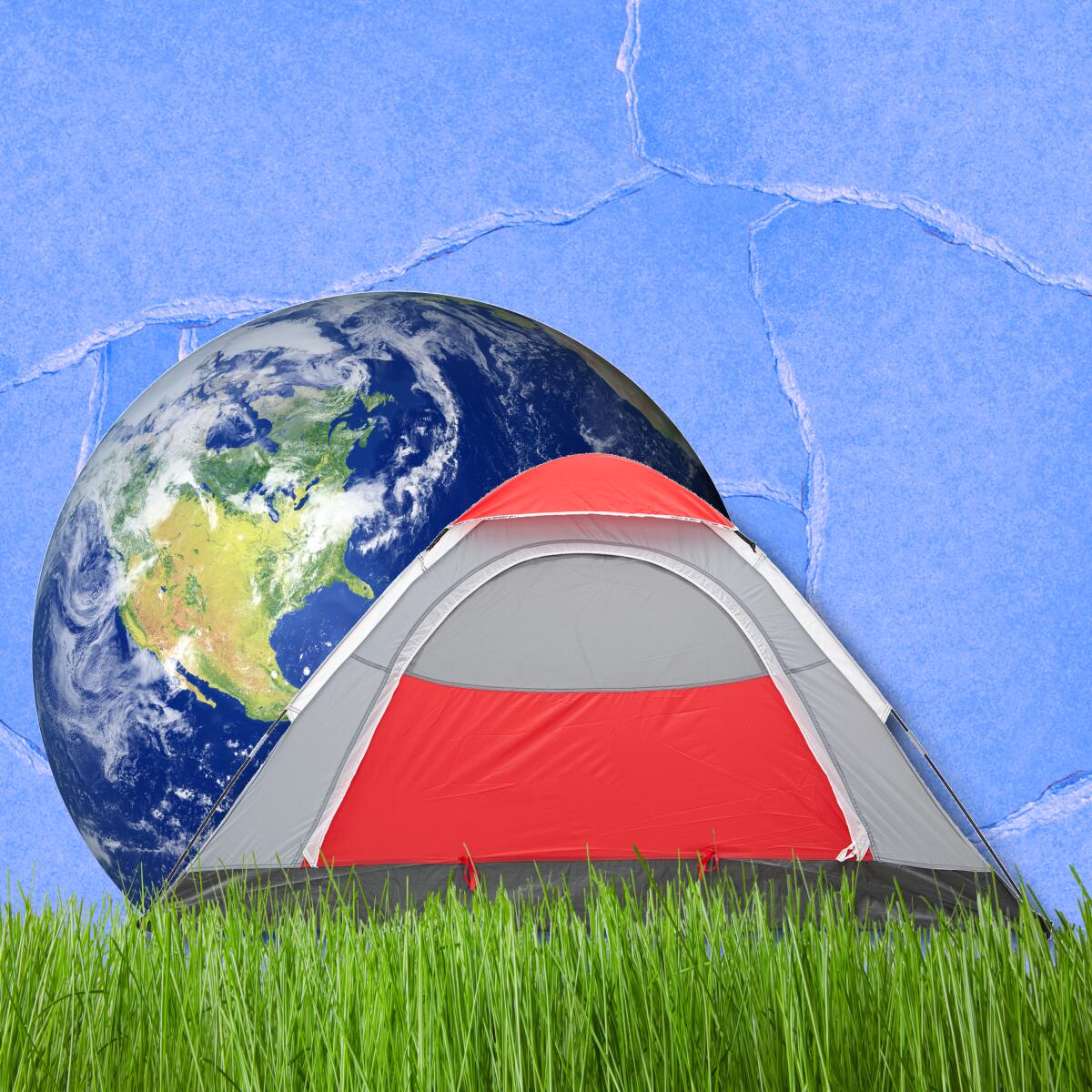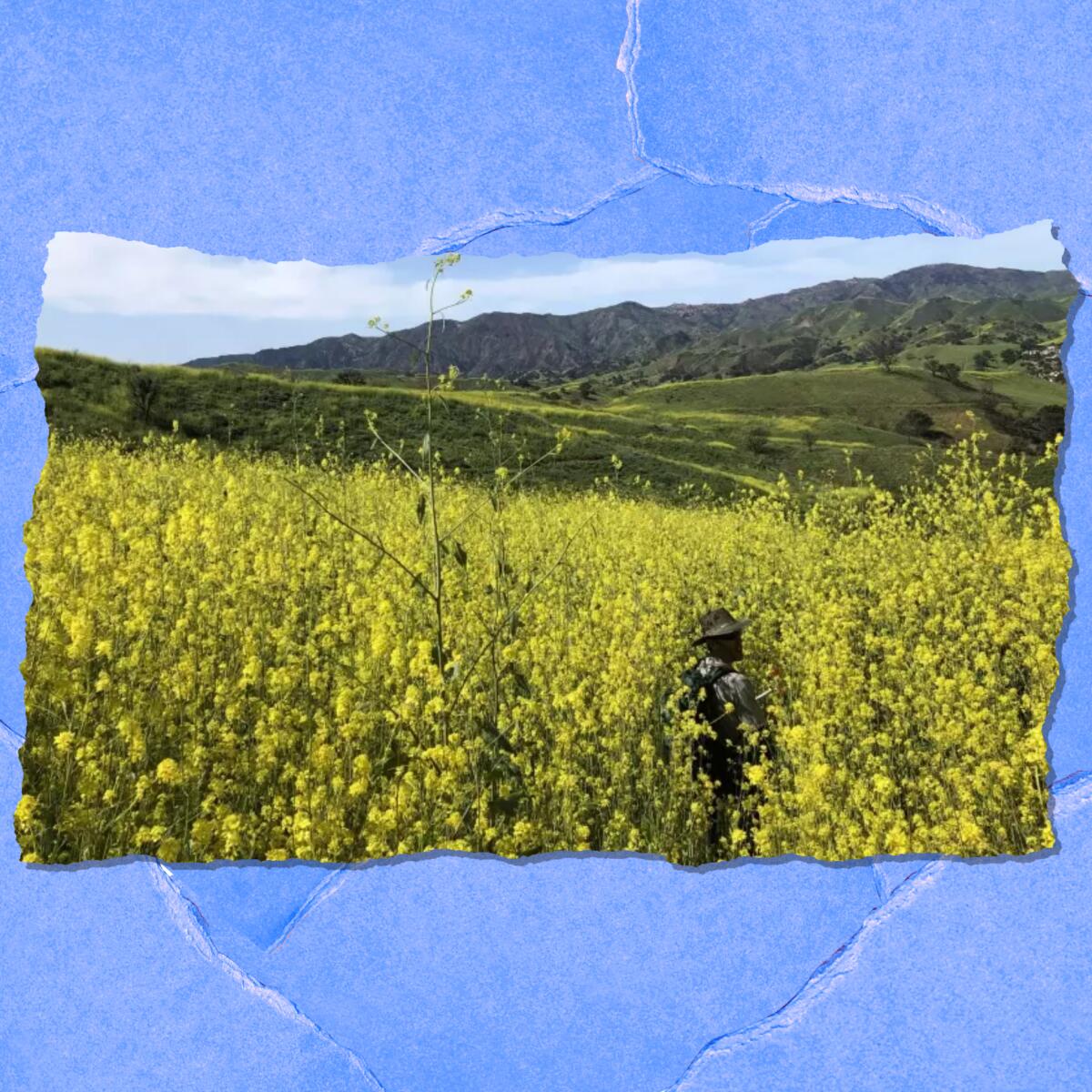5 hikes in SoCal for people who just really love trees

- Share via
Trees have been on my mind lately. I have a certain amount of respect for species taller than me, which most trees are. Redwoods make me feel puny, sycamores cool me down on hot days, blooming jacarandas shower me in purple snow, and coast live oaks arch gracefully over aromatic understories.
Luckily for me, there’s a national day to celebrate trees. It’s coming up soon, sort of.
Unlike Earth Day, designated in 1970 as April 22, a day for all of us to embrace the environment (here are 22 ways to celebrate in Southern California this year), the date for Arbor Day is a little more squishy. Nebraska led the way, proclaiming a legal tree-planting holiday in the state in 1885. Nowadays, every state marks Arbor Day, usually on the last Friday in April, which this year is the 29th.
But not California. Instead, the state marks California Arbor Week. It starts March 7, the birthdate of plant wizard and horticulturist Luther Burbank (not to be confused with the city named for dentist David Burbank), and continues until March 14. Still, there are local tree-worthy events coming up. You can help plant trees from 7:30 a.m. to 1 p.m. Saturday at Northside Park in Azusa and get pro tips from an arborist at 10 a.m. Saturday at 300 Norumbega Drive in Monrovia.
I think we should celebrate trees in March and April — and all year. Trees filter our air, reduce temperatures in overheated Los Angeles and bring much-needed beauty to gritty urban landscapes. Here are five hikes to put on your Arbor Day (or any day) list.
Orange County: Coastal redwoods aren’t native to Southern California, but tell that to the grove of wannabe giants at Carbon Canyon Regional Park in Brea. The trees are young (planted in 1975) and not as tall as those in native habitat up north. Still, it’s worth the 2.0-mile hike to see the more than 200 redwoods that thrive in their adopted home.
Santa Monica Mountains: The Musch Trail in Topanga State Park winds through oak woodlands and tree-framed meadows from Trippet Ranch on the way to Eagle Rock — the sandstone landmark, not the neighborhood. You get a feel for the sage and other plants that grow below oaks. The trail leads to a junction heading to Eagle Rock; you can retrace your steps (2.1 miles each way) or make a loop.
Mt. Wilson/Eaton Canyon: There’s nothing like hiking to a high point with a dense stand of conifers — coulters, sugar pines, Jeffery pines and more — to cool down. The shady oasis called Henninger Flats stands at 2,600 feet above sea level at the top of Eaton Canyon. The conifers were planted decades ago as an experimental forest. The site was once used as a tree nursery to replace those lost in forest fires. Today it’s a popular hiking destination, 5.5 miles round-trip, climbing about 1,400 feet on an exposed fire road.
Cucamonga Wilderness: The hike up Icehouse Canyon Trail near Mt. Baldy Village follows a wooded stream lined by oaks, alders and sycamores. In summer, linger under the shade while sticking your feet in the water. At higher and cooler elevations, take a lunch break under cedar, fir and pine trees. In fall, sycamore trees drop yellow leaves along the way. The strenuous trail (7.2 miles round-trip) climbs 2,600 feet to Icehouse Canyon Saddle, where you can access additional routes to Mt. Baldy and other peaks.
Griffith Park: The Hollywood sign and Mt. Hollywood are the scene stealers when it comes to hiking destinations in Griffith Park. There’s an out-of-the-way shady spot filled with cedars and picnic tables that’s less crowded — and inaccessible by car. You have lots of options to hike in; here’s a 2.3-mile round-trip loop route. Just make sure you stop and savor the trees.
3 things to do this week

1. How many species can you find? Join L.A.’s Nature Challenge. For the last six years, Angelenos have been exploring green spaces, finding species, snapping photos and uploading them to a website to record all of the discoveries in Los Angeles. Now you can join them. The City Nature Challenge, in which cities worldwide participate, runs from April 29 to May 2. Record your wildlife observations with the free mobile app iNaturalist. Here are tips on how to get started. Need more help? Attend a virtual iNaturalist training session from 7 to 8 p.m. Tuesday; register online in advance. You also can attend an iNaturalist Master Class on Zoom at 6 p.m. on Tuesday that will help you with identification skills and offer photo tips.

2. Camp overnight at an urban park in the South Bay. Bring your tent, sleeping bag and gear for an Earth Day campout at Hopkins Wilderness Park in Redondo Beach. The event costs $10, including breakfast. Check in and set up between noon and 7 p.m. Saturday. Then stick around to participate in Earth Day music and events at the park Sunday. Tickets must be purchased in advance.

3. Visit an exhibit and sale of watercolor landscapes by artist Luisa Millicent. The artworks in “A Walk in the Mountains” may look familiar to hikers, trail runners and mountain bikers. That’s because Luisa Millicent has aptly captured the natural profile of Southern California. The exhibit at the Santa Monica Mountains Interagency Visitor Center (26876 Mulholland Highway, Calabasas) continues through April 30 and features 125 works for sale, $25 to $875. The visitors center is open 9 a.m. to 4 p.m. Wednesdays through Sundays.
Wild things

How to save California’s wild salmon? It’s complicated, very complicated, as an L.A. Times report explains. For starters, the Sacramento River salmon are thriving in mountain rivers a world away in New Zealand. Yes, New Zealand. That’s where Chinook salmon eggs were shipped in the 1890s and 1900s. Now scientists have a plan to bring them back — but the Winnemem Wintu Tribe, which considers the salmon sacred, worry about the genetics of the overseas fish. Are they still California salmon? They have a different plan, believing the fish can thrive with a “swimway” to help them reach the river. Check out the full story and a video about the vanishing salmon.
The red flag

Mono Lake is in trouble. The drought has taken its toll on the Eastern Sierra lake, but so has L.A.’s need to divert water from streams in the area. “[T]he level of Mono Lake has fallen so low it has triggered a 72% reduction in the amount of water Los Angeles can divert from area streams this year,” The Times reported. Environmentalists have long worried about how L.A. taking water affects wildlife amid a prolonged drought and global warming.
The must-read

The best places to read in L.A.? Outside. So says former Times Books editor Carolyn Kellogg in an essay: “Los Angeles is made for reading. It’s always so beautiful outside. The variety of natural landscapes! And built environments! The perfect light! If reading takes you away from the world, L.A. allows you to also be in it, with the sun on your shoulders, the warmth of a concrete bench, the rustle of leaves. We are of this natural world, and L.A. invites readers to step out into it.” Another outdoor (and indoor) book connection: the Los Angeles Times Festival of Books 2022. It’s back as an in-person festival on Saturday and Sunday with hundreds of authors and events at USC. And it’s still free to attend.
Cool gear tips

What’s in your first-aid kit? There are lots of things you could bring, but here are items the Global Outdoor Emergency Support (GOES) health app recommends: bandages, paper tape or blister kit, disinfectant, scissors or knife/multitool, nitrile gloves, antibiotic ointment, a SAM splint, wound stapler/closer and tweezers. The most important thing is to keep your first-aid kit in your pack or bike panniers. Learn how to stay safe in the wild with the GOES app. Premium features are available to L.A. Times readers for free; enter the voucher code LATimesBenefit.
P.S.

I wrote about the “super doom” bloom of black mustard in Southern California. Pretty yellow fields? Yes, but the plant strangles out native wildflowers and creates fodder for wildfires. The Wild reader Nilo Ligi wrote with this suggestion:
“It was common knowledge in the Italian community that wild mustard is edible, in fact, delicious. Growing up on an orchard in Sonoma, one of my chores in winter was to pick the young plants for my mother to prepare for freezing so we’d have rapini all year round. I live in Sacramento now and still harvest the plants that grow along the American River. Black radish, ramolaccio, is also quite tasty and is almost as prolific as the mustard. It looks similar to the mustard but has whitish purple flowers. Of course, once the plants bloom, it’s too late to harvest them. One way to contain the spread of this plant might be to get the word out to the foragers.”
So maybe we can graze our way out of the problem? L.A. Times Today segment producer Nicolette Medina (@mylittlepasadenakitchen) substitutes mustard greens for Swiss chard in this tasty recipe by Katie Lee Biegel.
Enjoying this newsletter? Consider subscribing to the Los Angeles Times
Your support helps us deliver the news that matters most. Become a subscriber.
Send us your thoughts
Share anything that’s on your mind. The Wild is written for you and delivered to your inbox for free. Drop us a line at TheWild@latimes.com.
Click to view the web version of this newsletter and share it with others, and sign up to have it sent weekly to your inbox. I’m Mary Forgione, and I write The Wild. I’ve been exploring trails and open spaces in Southern California for four decades.

Sign up for The Wild
We’ll help you find the best places to hike, bike and run, as well as the perfect silent spots for meditation and yoga.
You may occasionally receive promotional content from the Los Angeles Times.




